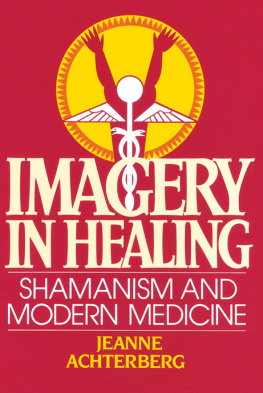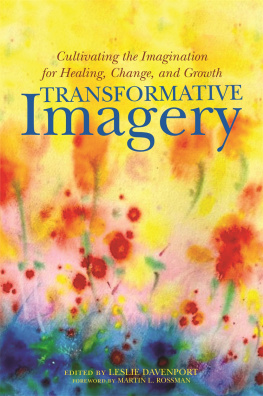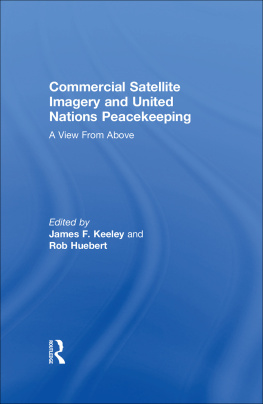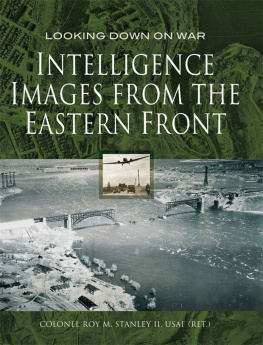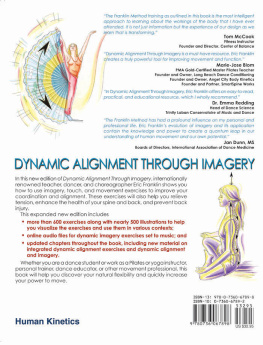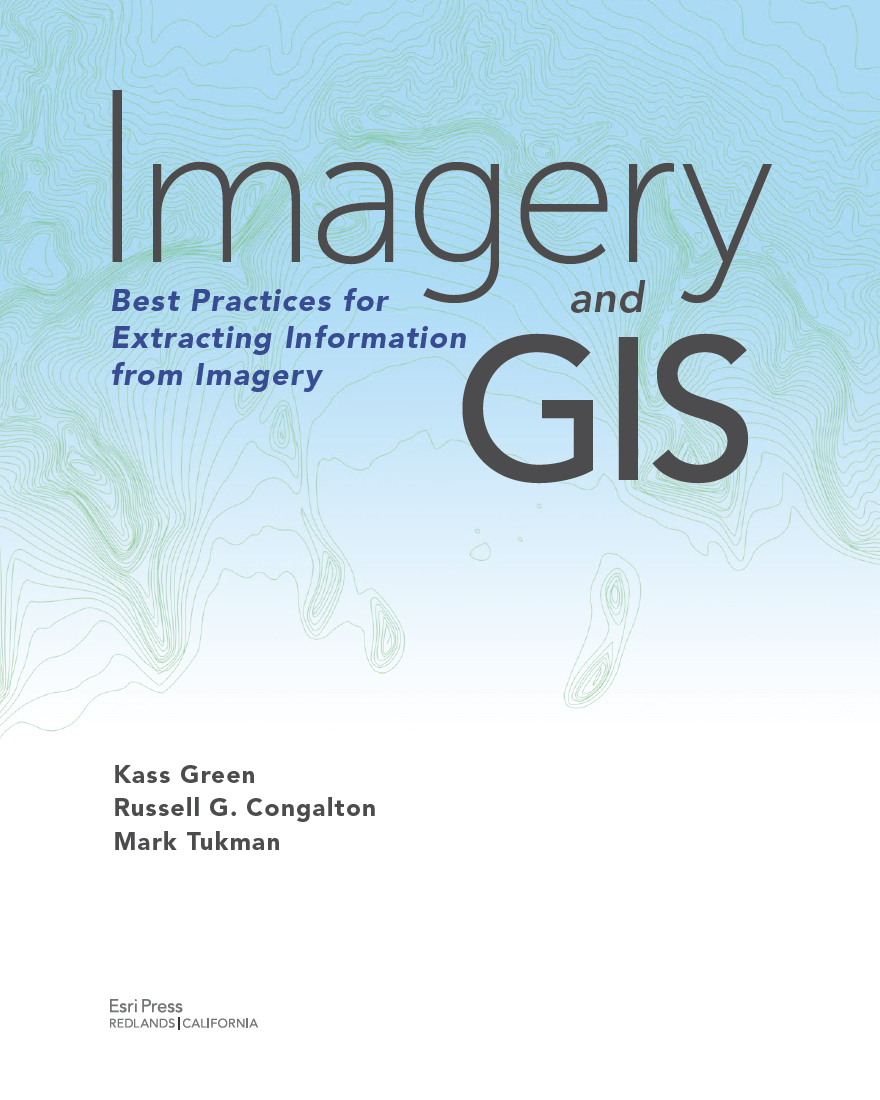
Cover credits : NASA/Earth Observatory; Garry Killian/Shutterstock
Esri Press, 380 New York Street, Redlands, California 92373-8100 154413
Copyright 2017 Esri
All rights reserved. First edition 2017
Printed in the United States of America
21 20 19 18 17 1 2 3 4 5 6 7 8 9 10
eISBN 9781589484894
Library of Congress has cataloged the print edition as follows:
Names: Green, Kass.
Title: Imagery and GIS : best practices for extracting information from imagery / Kass Green, Russell G. Congalton, and Mark Tukman.
Description: Redlands, California : Esri Press, [2017] | Includes bibliographical references and index.
Identifiers: LCCN 2017016441 | ISBN 9781589484542 (pbk. : alk. paper)
Subjects: LCSH: Remote sensing. | Geographic information systems. | Image processing.
Classification: LCC G70.4 .G743 2017 | DDC 621.36/78--dc23 LC record available at https://urldefense.proofpoint.com/v2/url?u=https-3A__lccn.loc.gov_2017016441&d=DwIFAg&c=n6-cguzQvX_tUIrZOS_4Og&r=RhmcbAxStnbJpr06ef1onNDeVX-gjVopdqeQ8i7DbIY&m=D46jekE3rLqAedyzhCR6CiiAjGL2PtB677NAry_6e8E&s=w10SupBXRhN_tmghKOJHZR5cg_2T3Fm6g8l3KW9nzM8&e=
The information contained in this document is the exclusive property of Esri unless otherwise noted. This work is protected under United States copyright law and the copyright laws of the given countries of origin and applicable international laws, treaties, and/or conventions. No part of this work may be reproduced or transmitted in any form or by any means, electronic or mechanical, including photocopying or recording, or by any information storage or retrieval system, except as expressly permitted in writing by Esri. All requests should be sent to Attention: Contracts and Legal Services Manager, Esri, 380 New York Street, Redlands, California 92373-8100, USA.
The information contained in this document is subject to change without notice.
US Government Restricted/Limited Rights: Any software, documentation, and/or data delivered hereunder is subject to the terms of the License Agreement. The commercial license rights in the License Agreement strictly govern Licensees use, reproduction, or disclosure of the software, data, and documentation. In no event shall the US Government acquire greater than RESTRICTED/LIMITED RIGHTS. At a minimum, use, duplication, or disclosure by the US Government is subject to restrictions as set forth in FAR 52.227-14 Alternates I, II, and III (DEC 2007); FAR 52.227-19(b) (DEC 2007) and/or FAR 12.211/12.212 (Commercial Technical Data/Computer Software); and DFARS 252.227-7015 (DEC 2011) (Technical Data Commercial Items) and/or DFARS 227.7202 (Commercial Computer Software and Commercial Computer Software Documentation), as applicable. Contractor/Manufacturer is Esri, 380 New York Street, Redlands, CA 92373-8100, USA.
@esri.com, 3D Analyst, ACORN, Address Coder, ADF, AML, ArcAtlas, ArcCAD, ArcCatalog, ArcCOGO, ArcData, ArcDoc, ArcEdit, ArcEditor, ArcEurope, ArcExplorer, ArcExpress, ArcGIS, arcgis.com, ArcGlobe, ArcGrid, ArcIMS, ARC/INFO, ArcInfo, ArcInfo Librarian, ArcLessons, ArcLocation, ArcLogistics, ArcMap, ArcNetwork, ArcNews, ArcObjects, ArcOpen, ArcPad, ArcPlot, ArcPress, ArcPy, ArcReader, ArcScan, ArcScene, ArcSchool, Arc-Scripts, ArcSDE, ArcSdl, ArcSketch, ArcStorm, ArcSurvey, ArcTIN, ArcToolbox, ArcTools, ArcUSA, ArcUser, ArcView, ArcVoyager, ArcWatch, ArcWeb, ArcWorld, ArcXML, Atlas GIS, AtlasWare, Avenue, BAO, Business Analyst, Business Analyst Online, BusinessMAP, CityEngine, CommunityInfo, Database Integrator, DBI Kit, EDN, Esri, esri.com, Esri Team GIS, Esri The GIS Company, Esri The GIS People, Esri The GIS Software Leader, FormEdit, GeoCollector, Geographic Design System, Geography Matters, Geography Network, geographynetwork.com, Geoloqi, Geotrigger, GIS by Esri, gis.com, GISData Server, GIS Day, gisday.com, GIS for Everyone, JTX, MapIt, Maplex, MapObjects, MapStudio, ModelBuilder, MOLE, MPS Atlas, PLTS, Rent-a-Tech, SDE, SML, SourcebookAmerica, SpatiaLABS, Spatial Database Engine, StreetMap, Tapestry, the ARC/INFO logo, the ArcGIS Explorer logo, the ArcGIS logo, the ArcPad logo, the Esri globe logo, the Esri Press logo, The Geographic Advantage, The Geographic Approach, the GIS Day logo, the MapIt logo, The Worlds Leading Desktop GIS, Water Writes, and Your Personal Geographic Information System are trademarks, service marks, or registered marks of Esri in the United States, the European Community, or certain other jurisdictions. CityEngine is a registered trademark of Procedural AG and is distributed under license by Esri. Other companies and products or services mentioned herein may be trademarks, service marks, or registered marks of their respective mark owners.
Ask for Esri Press titles at your local bookstore or order by calling 800-447-9778, or shop online at esri.com/esripress. Outside the United States, contact your local Esri distributor or shop online at eurospanbookstore.com/esri.
Esri Press titles are distributed to the trade by the following:
In North America: | In the United Kingdom, Europe, Middle East and Africa, Asia, and Australia: |
Ingram Publisher Services | Eurospan Group |
Toll-free telephone: 800-648-3104 | 3 Henrietta Street | Telephone: 44(0) 1767 604972 |
Toll-free fax: 800-838-1149 | London WC2E 8LU | Fax: 44(0) 1767 601640 |
E-mail: | United Kingdom | E-mail: |
For
Gene Forsburg and Jack McDevitt
Janet and Robert Congalton
Mel and Lois Tukman
Contents
Acknowledgments
This book would not have been possible without the generous contributions of our colleagues who reviewed the text, permitted us to include their graphics, provided case studies, and offered valuable insights. In particular we would like to thank Maggi Kelly, Gerald Kinn, Jarlath ONeil-Dunne, and Cassandra Pallai. We would also like to express our gratitude to the Sonoma County Agricultural Preservation and Open Space District, and the California Department of Fish and Wildlifeour project with them has enriched this book with many real world examples. Esri personnel have made this book truly professional and we thank their editors, product managers, application developers, and graphic artists. We are especially grateful to Esris Claudia Naber, who shepherded the book from inspiration to completion, and Peter Becker whose commitment, persistent questions, and leadership continually raised our standards and improved the content. Finally, we thank our families whose patience and support gave us the freedom and energy to pursue our passion for imagery and to share it with others in this book.
Section 1
Discovering Imagery
Chapter 1
Introduction
Why Imagery and GIS?
Imageryit allures and fascinates us; its measurements inform us. It draws us in to explore, analyze, and understand our world. First comes the astonishment of its raw beautythe enormity of a hurricane, the stark glaciers in Greenland, the delicate branching of a redwoods lidar profile, a jagged edge of a fault line in radar, the vivid greens of the tropics, the determined lines of human impact, the rebirth of Mount Saint Helens forests, the jiggly wiggly croplands of Asia and Africa, the lost snows of Kilimanjaro. Each image entices us to discover more, to look again and again.



